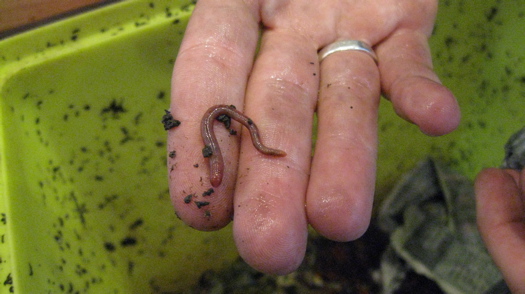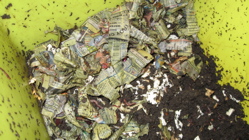Worms under the kitchen sink

He's not very photogenic-- but he's helpful.
Leah Walsh has worms.
Lots of them, in fact.
And they're living under her kitchen sink.
The Albany resident, whose blog Our Yellow House documents DIY crafts, cooking, gardening and raising her two girls in the mansion neighborhood, got the worms awhile back to help her compost food waste and garbage.
So how's that working out for her?
Last week I stopped by the eponymous house, which really is a beautiful sunshine-yellow in contrast to the drabber buildings next to it, to find out.
Leah and her family got the idea for the worms from a book called "The Urban Homestead." Officially the process is called vermicomposting.
Basically, it works like this: you "feed" your compostable scraps to the worms and in turn, they produce a nutrient-rich soil for use in your garden.
Pretty cool, right?

They started out in January with 10 containers of an earthworm variety called red wigglers that they bought from Conroy's Bait Shop in Watervliet. (It's an old-fashioned bait shop that instantly makes you feel like you've regressed a few decades- in a good way.) That's probably about 130-150 worms, which is definitely on the small side for most worm composting projects. Supplies for their small undertaking cost about $30 at most.

Using big brightly colored plastic tubs from Target, they set up the worm's habitat and voila, they were ready to begin. Leah says it's a surprisingly easy and low-maintenance project. The worms need to be "fed" about every 10 days. Typically, in Leah's house they puree some of their compostable scraps in the food processor first because it seems to make it easier for the worms to "digest" it, although that's not necessarily a requirement.
Certain things that can go in a regular compost bin aren't the best for worms, like citrus fruits and egg shells in high doses. Because you're working with living things, you do have to keep in mind a certain chemical balance. While an eggshell every now and then adds healthy calcium to the mix, the worms can't handle too many of them.
And every so often you "harvest" the soil the worms have enriched, switching it out for fresh soil and new food waste so the critters can begin their work all over again. Meanwhile, the composted soil goes to the garden. You can also use the worm soil to create a "worm tea," which is basically a mineral-rich liquid you can spray on plants as a natural fertilizer. But Leah says that's just kind of an experiment for now.
They aren't really getting much composted soil at this point, but eventually they may expand. Apparently several neighbors in the mansion district are also keeping worms, some of them in much larger operations. Leah says her whole family, especially 2-year-old Frances, were really into feeding the worms at first, but some of the novelty has since worn off.

So is it -- you know --gross?
Not really. It seemed miraculously clean. And while a lot of people might cringe at the idea of keeping a big container of the wriggling creatures in their house, the container has a lid and it's tall and slippery, so the worms stay in the bin.
What surprised me most about Leah's worms is the smell -- that is, the lack of smell. For some reason, I expected the worms and compost mixture to have a rank smell. There wasn't even that "after a summer rainstorm, earthwormy smell." A regular container of compost sans worms smells much worse to me than the worm bin does. Also, keeping soaked strips of newspaper on top of the soil helps prevent fruit flies. Leah keeps her worms under the sink, but if that freaks you out too much, or your operation is larger, they'd also do pretty well in a basement.
Say Something!
We'd really like you to take part in the conversation here at All Over Albany. But we do have a few rules here. Don't worry, they're easy. The first: be kind. The second: treat everyone else with the same respect you'd like to see in return. Cool? Great, post away. Comments are moderated so it might take a little while for your comment to show up. Thanks for being patient.
Comments
Very cool. Thank you Jessica for writing that!
May I ask what the paper strips are soaked with? Just plain water?
... said karin maag-tanchak on Oct 5, 2009 at 11:04 PM | link
yes, just plain water, got to keep those worms hydrated
... said jalarson on Oct 7, 2009 at 2:36 PM | link